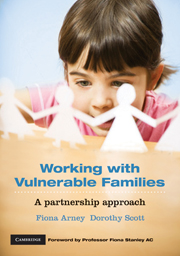Book contents
- Frontmatter
- Foreword
- Contents
- List of figures, tables and boxes
- Contributors
- Acknowledgements
- Introduction
- Chapter 1 Think child, think family, think community
- Chapter 2 Family strengths: an international perspective
- Chapter 3 Harnessing ‘resilience’ when working with children and families
- Chapter 4 Working within and between organisations
- Chapter 5 Family-centred practice in early childhood settings
- Chapter 6 Sustained nurse home visiting with families of Aboriginal children
- Chapter 7 Including fathers in work with vulnerable families
- Chapter 8 Parenting in a new culture: working with refugee families
- Chapter 9 Responding to parents with complex needs who are involved with statutory child protection services
- Chapter 10 Engaging family members in decision making in child welfare contexts
- Chapter 11 Supporting parents whose children are in out-of-home care
- Chapter 12 Using evidence-informed practice to support vulnerable families
- Chapter 13 Spreading promising ideas and innovations in child and family services
- Index
Chapter 10 - Engaging family members in decision making in child welfare contexts
- Frontmatter
- Foreword
- Contents
- List of figures, tables and boxes
- Contributors
- Acknowledgements
- Introduction
- Chapter 1 Think child, think family, think community
- Chapter 2 Family strengths: an international perspective
- Chapter 3 Harnessing ‘resilience’ when working with children and families
- Chapter 4 Working within and between organisations
- Chapter 5 Family-centred practice in early childhood settings
- Chapter 6 Sustained nurse home visiting with families of Aboriginal children
- Chapter 7 Including fathers in work with vulnerable families
- Chapter 8 Parenting in a new culture: working with refugee families
- Chapter 9 Responding to parents with complex needs who are involved with statutory child protection services
- Chapter 10 Engaging family members in decision making in child welfare contexts
- Chapter 11 Supporting parents whose children are in out-of-home care
- Chapter 12 Using evidence-informed practice to support vulnerable families
- Chapter 13 Spreading promising ideas and innovations in child and family services
- Index
Summary
Learning goals
This chapter will enable you to:
Develop an understanding of the origins of family decision-making models of practice in child welfare
Place this development in the context of rights-based practice
Identify the key elements and knowledge base of family decision-making models of practice
Understand the key stages of the Family Group Conference as an example of family decision making
Reflect upon the possibilities of using family decision making in your own practice.
Introduction
Many services support the notion of involving families in decision making. The nature or extent of that family engagement in a child welfare context, however, creates a range of responses that are often influenced by societal pressures and competing demands (Connolly, 1999). Conceptualising family participation across levels of practitioner response is a useful way of understanding the extent of service commitment to meaningful family involvement (Connolly & Ward, 2008).
At the most basic level, families are consulted and their views taken into account. This requires that the practitioner listen to the family and consult over what may need to happen to resolve the concerns they may have. The next level will see families actively contributing to solutions. Here service providers demonstrate confidence in the family and trust family-led problem-solving. A higher level still of family participation might then see the proactive seeking of family feedback as a service user – and using that feedback to constructively improve services.
- Type
- Chapter
- Information
- Working with Vulnerable FamiliesA Partnership Approach, pp. 209 - 226Publisher: Cambridge University PressPrint publication year: 2010
- 2
- Cited by



